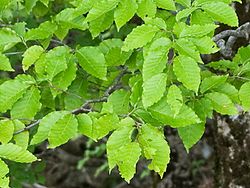| Japanese blue beech | |
|---|---|
 | |
| Scientific classification | |
| Kingdom: | Plantae |
| Clade: | Tracheophytes |
| Clade: | Angiosperms |
| Clade: | Eudicots |
| Clade: | Rosids |
| Order: | Fagales |
| Family: | Fagaceae |
| Genus: | Fagus |
| Species: | F. japonica |
| Binomial name | |
| Fagus japonica | |
Fagus japonica, known as the Japanese beech, Japanese blue beech or in Japanese as inubuna ("dog buna") or kurobuna ("black buna"), is a deciduous tree of the beech family Fagaceae.
